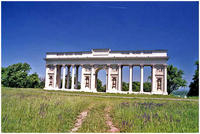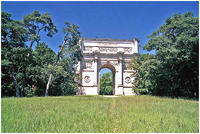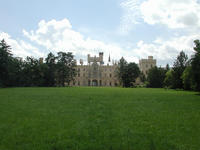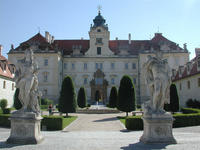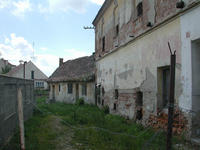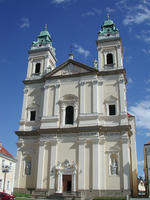| Site number: | 763 |
|
| Type of site: | Cultural | |
| Date: | 17-20th cent. | |
| Date of Inscription: | 1996 | |
| Location: | Europe, Czech Republic, South Moravian Region, Breclav District | |
| Description: | Liechtenstein ruling dukes, amid the 17th and 20th centuries, transformed their southern Moravian realms into a striking landscape. They created a fusion of the classical and neo-Gothic style of Lednice and Valtice castles and Baroque architecture (chiefly the work of Johann Bernhard Fischer von Erlach) together with the romantic English countryside architecture. Stretching 200 sq. km, Lednice-Valtice Cultural Landscape is one of the largest man-made landscapes in Europe. --WHMNet paraphrase from the description at WHC Site, where additional information is available. | |
| The Lednice-Valtice Cultural Landscape (also Lednice-Valtice Area or Lednice-Valtice Complex, Czech: Lednicko-valtický areál) is a cultural-natural complex of 283,09 km² in the Czech Republic, South Moravian Region, close to Břeclav and Mikulov, next to another site registered by UNESCO - Pálava Landscape Protected Area. During the 18th and 19th centuries the area was transformed by local manor lordship - the House of Liechtenstein - into some large landscape park with two centres: Valtice Castle (and contiguous town), Lednice Castle (and contiguous village). These two localities are connected by so called Bezruč Avenue (from 1715). There are also one more village - Hlohovec. Between Lednice, Valtice and Hlohovec the Lednice Ponds (Lednické rybníky) are situated (Mlýnský, Prostřední, Hlohovecký and Nesyt Ponds). A substantial part of the complex is covered with the Pine wood (Boří les) and partially with a riparian forest adjacent to the River Dyje.
Except for above mentioned, there are a lot of bigger or smaller pavilions scattered throughout the whole complex (they often served as hunting lodges): Rajsna (German: Reistna, The Colonnade) - a Classicist colonnade on the top of a hill ridge above Valtice (like a gloriette) from 1810s-1820s; Belvedere; Rendezvous (or Temple of Diana) - a hunting lodge in a form of a Classicist arch from 1810s; St Hubert Chapel (Kaple svatého Huberta)- a Neo-Gothic column structure from 1850s dedicated to the patron saint of hunters, situated in the Pine wood; Border House (Hraniční zámeček) - a Classicist chateau built in 1820s directly on the former (until 1920) bordline between Lower Austria and Moravia; Temple of the Three Graces (Tři Grácie) - a semicircle gallery with allegorical statues of Sciences and Muses and a statue of the Three Graces from 1820s; Pond House (Rybniční zámeček)- ashore of one of the Lednice Ponds; Nový dvůr (German: Neuhof, New Farm) - a Classicist farm finished in 1809, originally used for sheep husbandry, nowadays for horse breeding; Apollo Temple (Apollónův chrám)- a Classicist hunting lodge from 1810s, ashore of one of the Lednice Ponds; Hunting Lodge (Lovecký zámeček)- a Classicist house from 1806; John's Castle (Janohrad)- a Neo-Gothic "artificial ruins" (Czech: umělá zřícenina, German: künstliche Ruine) in style of a castle, finished in 1810; Minaret- a Moorish Revival structure (62 m high) in the Lednice Castle garden (finished in 1804), it serves as an observation tower; Obelisk- erected in memory of the peace treaty of Campo Formio (1798); Pohansko - an Empire-style hunting lodge finished after 1812, it houses an exhibition of Břeclav Town Museum:close to the lodge there are both an important archaeological site of Great Moravian remains and reconstructed parts of the Czechoslovak border fortifications; Lány - an Empire-style hunting lodge from the beginning of the 19th century. --Wikipedia. Text is available under the Creative Commons Attribution-ShareAlike License. |
||
| Source: | http://whc.unesco.org/en/list/763 | |
| Reference: | 1. UNESCO World Heritage Center, Site Page. | |



